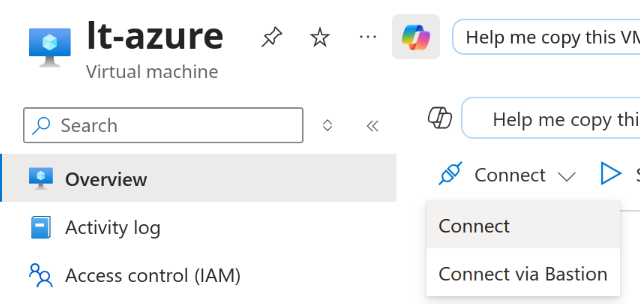Prepare host OS
Prepare host OS in the Microsoft Azure Cloud.
SSH to the host OS
Go to the Overview page of your virtual machine instance, click Connect → Connect, and follow the instructions to establish an SSH connection to the host operating system using your downloaded private key.

Azure's default user is by default azureuser, use the following command to SSH to your instance (to the host OS). On Linux and macOS, you'll first need to limit the key file permissions using the chmod command.
chmod 400 path/to/your-private-key.pemssh -i path/to/your-private-key.pem azureuser@INSTANCE_IPDisable nouveau driver
sudo modprobe -r nouveauBlacklist nouveau at boot
echo "blacklist nouveau" | sudo tee /etc/modprobe.d/blacklist.confUpgrade OS
sudo apt upgrade -yInstall NVIDIA GPU driver
sudo apt-get update
sudo apt install nvidia-headless-535 nvidia-utils-535 libnvidia-encode-535
sudo modprobe nvidia
nvidia-smiReboot the instance
sudo rebootInstall Docker CE
curl https://get.docker.com | sh && sudo systemctl --now enable docker
sudo groupadd docker
sudo usermod -aG docker $USER
newgrp docker
groupsInstall NVIDIA Container Toolkit
curl -fsSL https://nvidia.github.io/libnvidia-container/gpgkey | sudo gpg --dearmor -o /usr/share/keyrings/nvidia-container-toolkit-keyring.gpg \
&& curl -s -L https://nvidia.github.io/libnvidia-container/stable/deb/nvidia-container-toolkit.list | \
sed 's#deb https://#deb [signed-by=/usr/share/keyrings/nvidia-container-toolkit-keyring.gpg] https://#g' | \
sudo tee /etc/apt/sources.list.d/nvidia-container-toolkit.list
sudo apt-get update
export NVIDIA_CONTAINER_TOOLKIT_VERSION=1.17.7-1
sudo apt-get install -y \
nvidia-container-toolkit=${NVIDIA_CONTAINER_TOOLKIT_VERSION} \
nvidia-container-toolkit-base=${NVIDIA_CONTAINER_TOOLKIT_VERSION} \
libnvidia-container-tools=${NVIDIA_CONTAINER_TOOLKIT_VERSION} \
libnvidia-container1=${NVIDIA_CONTAINER_TOOLKIT_VERSION}
sudo nvidia-ctk runtime configure --runtime=docker
sudo systemctl restart dockerInstall Docker Compose
sudo curl -L https://github.com/docker/compose/releases/latest/download/docker-compose-$(uname -s)-$(uname -m) -o /usr/local/bin/docker-compose
sudo chmod +x /usr/local/bin/docker-compose
docker-compose versionIncrease max UDP kernel buffer size
SYSCTL_CONF="/etc/sysctl.d/10-udp-buffer-size.conf"
sudo sh -c "echo '#kernel send a receive windows buffer sizes' > $SYSCTL_CONF"
sudo sh -c "echo 'net.core.rmem_max=262144000' >> $SYSCTL_CONF"
sudo sh -c "echo 'net.core.wmem_max=262144000' >> $SYSCTL_CONF"
sudo sh -c "echo 'net.core.rmem_default=262144000' >> $SYSCTL_CONF"
sudo sh -c "echo 'net.core.wmem_default=262144000' >> $SYSCTL_CONF"
sudo sh -c "echo '' >> $SYSCTL_CONF"
sudo sysctl -p $SYSCTL_CONFIncrease txqueuelen for network interfaces
sudo bash -c 'cat > /etc/udev/rules.d/80-txqueuelen.rules' << EOF
SUBSYSTEM=="net", ACTION=="add|change", KERNEL=="e*", ATTR{tx_queue_len}="10000"
EOF
sudo udevadm control --reload-rules && sudo udevadm triggerDisable mDNS on the host
The mDNS service mustn't be active in the host OS for NDI discovery to work. If present, this command removes it from the host OS:
sudo dpkg -l | grep "avahi-daemon"
sudo apt remove --purge avahi-daemon -yInstall systemd-coredump
It's needed for the creation of diagnostic packages when something goes wrong.
sudo apt install systemd-coredumpConfigure cgroup settings
Edit the Configuration File /etc/docker/daemon.json and add or modify the cgroup-related settings
{
"default-cgroupns-mode": "host"
}If your daemon.json file already contains the runtimes configuration for NVIDIA, you can simply add additional configuration for cgroup settings without overwriting the existing content:
{
"runtimes": {
"nvidia": {
"args": [],
"path": "nvidia-container-runtime"
}
},
"default-cgroupns-mode": "host"
}Save the file and restart the Docker daemon to apply the changes:
sudo systemctl restart dockerYour instance is fully prepared to run Live Transcoder in Docker.
Updated 23 days ago
